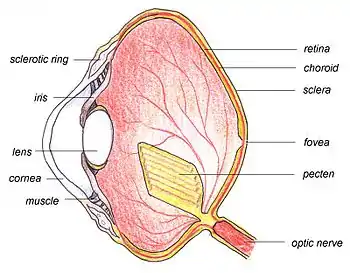Pecten oculi
The pecten or pecten oculi is a comb-like structure of blood vessels belonging to the choroid in the eye of a bird. It is a non-sensory, pigmented structure that projects into the vitreous humor from the point where the optic nerve enters the eyeball.[1] The pecten is believed to both nourish the retina and control the pH of the vitreous body.[2] High level of enzyme alkaline phosphatase activity in pecten oculi has been linked to transport of nutrient molecules from highly vascularized pecten oculi into vitreous and then into retinal cells for nourishment.[3] It is present in all birds and some reptiles.[4]

In the vertebrate eye, there are blood vessels in front of the retina, partially obscuring the image. The pecten helps to solve this problem by greatly reducing the number of blood vessels in the retina and leading to the extremely sharp eyesight of birds such as hawks.[5] The pigmentation of the pecten is believed to protect the blood vessels against damage from ultraviolet light. Stray light absorption by melanin granules of pecten oculi is also considered to give rise to small increments in temperature of pecten and eye; this may offer increased metabolic rate to optimize eye physiology in low temperatures at high-altitude flights.[6] The structure varies across bird species and is conical in the kiwi, vaned in the ostrich and pleated in most other birds.[7]
See also
- Conus papillaris, a similar structure found in reptiles
References
- Walls (1942), The Vertebrate Eye and its Adaptive Radiation, Hafner Publishing, ISBN 0-02-854430-7
- Kiama, S. G.; Maina, J. N.; Bhattacharjee, J.; Weyrauch, K. D. (2001). "Functional morphology of the pecten oculi in the nocturnal spotted eagle owl (Bubo bubo africanus), and the diurnal black kite (Milvus migrans) and domestic fowl (Gallus gallus var. domesticus): a comparative study". Journal of Zoology. 254 (4): 521–528. doi:10.1017/s0952836901001029.
- Bawa, S R; YashRoy, R C (1972). "Effect of dark and light adaptation on the retina and pecten of chicken". Experimental Eye Research. 13 (1): 92–97. doi:10.1016/0014-4835(72)90129-7. PMID 5060117.
- Bonney, Rick; Rohrbaugh, Jr., Ronald (2004), Handbook of Bird Biology (2nd ed.), Princeton, NJ: Princeton University Press, ISBN 0-938027-62-X
- Ainsworth, Claire; Le Page, Michael (August 11, 2007), "Evolution's greatest mistakes" (PDF), New Scientist, 195 (195.2616): 36–39, doi:10.1016/S0262-4079(07)62033-8, retrieved 7 November 2016
- Bawa, S R; YashRoy, R C (1974). "Structure and function of vulture pecten". Cells Tissues Organs. 89 (3): 473–480. doi:10.1159/000144308. PMID 4428954.
- Kiama, S G; Bhattacharjee, J; Maina, J N; Weyrauch, K D (December 1994), "A scanning electron microscope study of the pecten oculi of the black kite (Milvus migrans): possible involvement of melanosomes in protecting the pecten against damage by ultraviolet light", Journal of Anatomy, 185 (Pt 3): 637–642, PMC 1166670, PMID 7649799